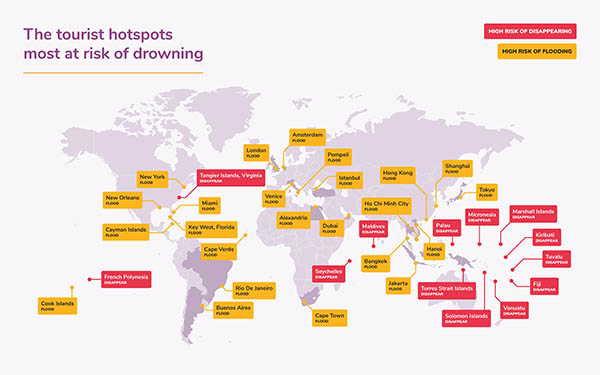About the author
Ben Gallizzi
Ben Gallizzi, Senior Content Editor, uSwitch.com
Energy expert Ben Gallizzi is money.co.uk's authority on all things energy, making sure all energy content on the site is kept 100% accurate and up to date.
Asia's leisure industry news and information platform - from Saudi to Sapporo, Bali to Beijing

With global warming and sea levels rising and some of our most popular tourist destinations at risk of being lost in the next 100 years, energy experts investigated which tourist hotspots are most at risk.
It’s no secret that global warming and sea levels are rising. According to the Intergovernmental Panel on Climate Change (IPCC), the global sea levels will rise between 0.43metre and 0.84 metrew by 2100. Meaning that if we don’t take action now to help reduce the impacts of climate change, many of our favourite holidaying destinations could be completely submerged. The risk of surging sea-levels means your future great-grandchildren may never experience the wonders of places like Rio de Janeiro, Dubai, or Venice.
It’s vital global warming is combatted to reduce the chance of these incredible cities becoming lost forever. To help put this danger into perspective, a number of posters have been created which reimagine how some of the most popular holiday destinations could look by 2100 if sea levels continue to rise dramatically.
Hong Kong, a thriving, energetic city that sees approximately 56 million tourists every year according to Statista, is facing a sea-level rise of 0.6-1.3metre rise by 2100. This could have devastating effects on 8.4 million vulnerable residents in low-lying areas who would be exposed to extreme flooding.
Known for its white sands and crystal waters, the Maldives is an idyllic paradise - but it’s extremely vulnerable to rising sea levels. As one of the flattest countries in the world, even the smallest change in sea level could cause harm. Currently, 80% of the island is only one metre above sea level, and it’s estimated that by 2100, 77% of the Maldives land area could be underwater.

New York currently has the largest population living inside a floodplain and with sea levels predicted to rise by as much as 1.8 metres by 2100, this could potentially become a very dangerous place to be, especially in low-lying parts of the city such as Brooklyn and Queens.
For many years people have said that Venice is sinking, and now, with the acceleration of global warming, we could lose this ancient and iconic city sooner than we thought. With the sea level estimated to rise by 1.04 metre by 2100, it’s likely Venice will see extreme flooding every five years by 2050 and every five months by 2100.
Which tourist destinations are the most vulnerable to rising sea levels?
The map below is of tourist destinations around the world that are at risk of rising sea levels, flooding and even disappearing completely.

Fiji, a country where the economy is largely based on tourism, has already started to see the effects of rising sea levels with research showing that it will continue to rise to one to two metres by 2100, which risks the island being submerged completely. Seychelles, Solomon Islands and Palau are all also at risk of disappearing by 2100, which would be a devastating loss to the planet.
Some of the most popular tourist destinations in the world including London, Dubai, Tokyo and Rio de Janeiro are vulnerable to extreme flooding by 2100. In London, at least one million people live in the natural floodplain with 16% of the city’s properties at significant risk to sea levels rising.
In Dubai, a rise of three metres would see the Emirate city lose much of its infrastructure. If the sea levels rise to nine metres, then it’s estimated that Dubai would be entirely submerged, making it the shortest-lived elaborate infrastructure in human history.
The impact of rising sea levels can be catastrophic to our planet, causing the world to look very different by 2100. And while it seems like an inevitable movement, reducing your carbon footprint and switching energy to suppliers using renewable sources can help to slow down the rising levels, giving the cities most likely to be affected time to plan and prepare.
Click here to view the original article.
Images: To help put climate change into perspective, posters reimagine how some of the most popular holiday destinations could look by 2100 if sea levels continue to rise dramatically.
15th December 2020 - South East Queensland and northern NSW coasts hit by ‘dangerous’ weather
1st December 2020 - Singapore enters into a climate change bilateral Dialogue with the United Kingdom
26th November 2020 - Darwin Lord Mayor calls for immediate action on Climate Change to mitigate impacts on facilities and environment
2nd August 2020 - Sentosa Golf Club first to join sign up to United Nations Sports for Climate Action Initiative
5th July 2020 - Former Socceroo pushes for 2023 Women’s World Cup to amplify climate change urgency
29th May 2020 - Storm smashes Margaret River visitor attraction
7th April 2020 - Reef tourism industry and conservationists demand climate action following release of new bleaching survey
28th February 2020 - Australian Marine Conservation Society calls for a Reef-safe climate policy
20th January 2020 - New report aims to prompt recognition of climate change threat to Australian Open
30th December 2019 - Research finds Australian cricket not ready for challenges of climate change
6th December 2019 - Tourism Report calls for more effective climate change strategies to save our oceans
4th December 2019 - World Travel and Tourism Council calls for Climate Neutrality by 2050
16th October 2019 - Councils and water industry call for national water focus amid climate change
20th September 2019 - International sport bodies unite to combat climate change
18th September 2019 - New report highlights the increased threat of climate change on Australian wildlife
5th July 2019 - Massive tree planting has potential to tackle climate crisis
26th June 2019 - Research shows Great Barrier Reef visitors understand climate threat
16th May 2019 - University of Queensland predicts climate change could cause the extinction of 26 species
6th February 2019 - Climate change set to impact Australia’s summer sporting calendar
6th March 2014 - Study fears global tourism icons at risk from rising sea levels
10th February 2011 - Sand disappears at famous Thai beach